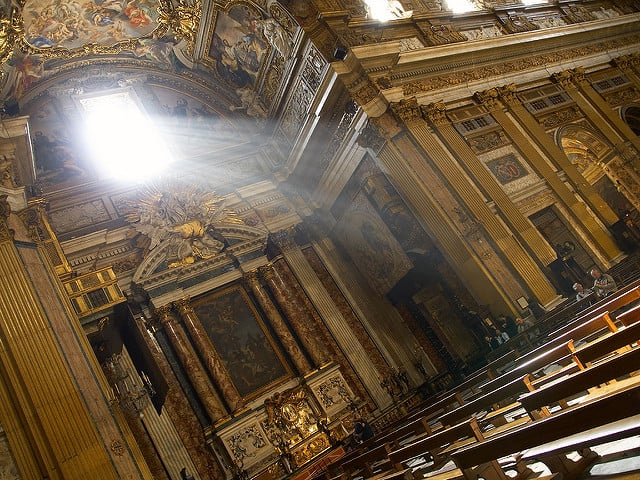In Madrid we live in apartment flats (pisos) and our house chapel is a converted bedroom – a rather small bedroom. For our community of fifteen fully grown Jesuits, it can be a tight fit. The space is about twice as long as it is wide, so we sit on a bench against one of the longer walls, leaving just enough room for the presiding priest to face us from the other side of a narrow altar. If you’ve ever wondered why the disciples are all on one side of the table in Da Vinci’s Last Supper, here’s a possible explanation: perhaps they were dining in someone’s bedroom.
Most people experience the liturgy from a distance, noticing arms raised and lowered, the mixing of water and wine, the shuffle of plates, cups, and candles. For most people, everything happens somewhere up there. In our chapel there is no up there, no long processions, no smoke and mirrors; the back row is the front row and you can’t help but notice every last detail. It all happens, quite literally, right before your eyes. I’ve basically memorized the nervous tics of each presiders’ hands, their habits of turning pages, breaking bread, pouring wine.
I, like many people, normally adopt a ‘safe-distance’ approach to the sacraments — hoping to experience God at my own pace and on my own terms — so, at first, this bedroom-chapel arrangement was a little jarring. What had been a public ritual celebrated in big cavernous churches, had become an intimate act, a personal experience — a fitting preparation, I suppose, for my own ordination. What was once a kind of magic has become, by grace, mundane.
***
I recently went to Rome and visited the mother church of the Jesuits, the Gesu. Let me assure you — it’s one mother of a church. Baroque exuberance at its best, the Gesu is overwhelmingly beautiful without falling, as so much baroque art does, into the hopelessly gaudy. This church is flooded with the full force of the Ignatian imagination, the greater glory of God crammed into every last detail. I imagine the Jesuit poet Gerard Manley Hopkins would marvel at it all — a temple turned playground where the eye can’t help but tumble from one thing to the next, the whole church charged with the grandeur of God, angels and saints flaming out all over the place.
My early liturgical experiences took place in moldy gymnasiums that smelled of adolescent boys and industrial grade disinfectant – first at my Catholic high school and later as a volunteer at Central Juvenile Hall in downtown LA. I recalled those gym-masses as I stood in the Gesu and remembered something I once heard one of those jail priests say, trying to encourage reluctant kids to come forward for communion or a blessing: “Sometimes we fear this moment because we think it’s too sacred for us, but the greater risk is forgetting that it’s also a meal where all are wanted and everyone welcomed.”
There is no risk, in the Gesu church, of forgetting that what happens there is sacred. There is greater risk of forgetting that what we memorialize there was a simple meal – a last supper for a soon to be convict. In that great stone church, dedicated to the name of Jesus, we gather to consecrate our most humble gifts and we pray that they become his body and blood. At the center of all that polished marble we are moved most by a bit of bread and a cup of wine.
In one corner of the church a large painting hides a silver statue of Ignatius – a real ‘man of steel’. Every afternoon a baroque mechanism (fabulously called a ‘conversion machine’) scrolls away the painting, dramatically revealing the statue behind – it’s basically the 17th century equivalent of a gif. Watching the whole show unfold it struck me that we also risk forgetting that Ignatius, like Christ, like us, was human. Fleshy and fallen, by many measures, a failure.
***
Back in Madrid one of our beloved elder Jesuits made us smile recently during a daily liturgy by absentmindedly taking the elevation of the host as a convenient time to simultaneously glance at his watch. It wasn’t a grave crime, just the liturgical pragmatism of a septuagenarian priest saying mass in a converted bedroom. He probably needed to take a pill at a certain hour, something that – through him, with him, and in him – he didn’t want to forget.
This same priest began showing signs of Parkinson’s earlier this year. His hands shake when he’s not focused. I watch them move through the liturgy like I’d watch my mother’s hands in the kitchen as a kid, like I’d watch the hands of a woodworker or a calligrapher. They know well the pages, the tabs, the ribbons, the simple rhythm of it all. That he can recite the prayers while checking the time is actually a kind of proof of faithfulness – if not attentiveness – and even his liturgical blunders are a memorial of grace.
Watching his hands I am reminded of how the sacred is poured out in frailty, how the mundane is made holy in fidelity. In a bedroom chapel, a jailhouse gym, or the Gesu church, in all things and in every moment, it’s good to remember that we are all held together by a few trembling hands and a little holy communion.
–//–
The cover image by Flickr user Darren Copley can be found here.


